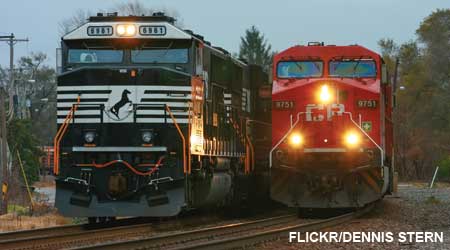Stay updated on news, articles and information for the rail industry
December 2008
Part 1 : INTRO: '09 Outlook: Rail & Reconstruction
Part 2 : PART 1: Class Is Like Their Chances of Posting Revenue Gains & Easing Cost Pains in '09
Part 3 : PART 2: For Short Lines, Top-Line Growth is an '09 Goal
Rail News: Rail IndustryPART 1: Class Is Like Their Chances of Posting Revenue Gains & Easing Cost Pains in '09
By Jeff Stagl, Managing Editor
Fred Green believes Class I chief executive officers are more seasoned at managing their railroads in difficult times than in good times.
During the 1980s, 1990s and early 2000s, Class Is focused more on trimming expenses and minimizing fixed costs, while during the past four years, they’ve concentrated more on top-line growth — a management skill the CEOs practically had to relearn, says Green, Canadian Pacific Railway’s president and CEO.
Wick Moorman concurs that Class I top execs have quite a bit of practice at navigating rough waters.
“But I think we’re equally adept at managing in both good and bad times,” says Norfolk Southern Corp.’s chairman, president and CEO. “We had a downturn in 2000 and 2001, and we know how to react now, and we will react.”
The seven Class I CEOs know they’ll need to rely more than ever on their all-around managing skills because times are really bad — as in recession-and-financial-market-mess bad. To survive what figures to be a long stretch of tough times ahead, the execs are trying to find ways to counteract a withering economy and languishing traffic volumes.
During interviews with two CEOs, and in statements either emailed to Progressive Railroading last month or made at third-quarter earnings conferences in late October by the five others, the top execs shared their strategies for increasing revenue, controlling costs and making their voices heard in a new Administration and Congress next year. The overriding theme in their ’09 charge: stay the growth course even though an economic upturn might not come until late next year.
While most of the CEOs characterized 2008 as a good year in light of economic conditions, they’re all convinced 2009 is an unknown quantity.
“There is high, high uncertainty here. Economic indicators are all over the map,” says CSX Corp. Chairman, President and CEO Michael Ward.
Adds Moorman: “I’m not sure what the bottom is or how long the downturn will last. I’m very cautious and guarded in my outlook for 2009.”
Smooth ride on revenue side
Nonetheless, the CEOs are projecting revenue increases despite soft overall traffic demand. Although none provided a forecasted percentage-point gain, all agreed that revenue will be driven partially by fuel surcharges assessed against still-high diesel prices and predominantly by rate hikes.
“The opportunities for pricing vibrancy are intact,” says Ward. “There’s still room to price our service to market conditions. Our perspective is longer term, and not based on next week or next year.”
Rate increases will help Kansas City Southern at least come close to an ’09 revenue target the Class I set a few years ago as part of a five-year plan.
At the time, KCS stated that revenue would grow 10 percent to 14 percent compounded annually and traffic would increase by single digits, said KCS Chairman and CEO Mike Haverty in an email.
“We stated that our projections were based on the economy remaining at the general level it was during first-quarter 2007, and obviously it hasn’t,” he said. “Much of the downturn we’ve been able to mitigate through bringing on new business, improving operating efficiencies and strong pricing initiatives. However, we’ve come to a point in the economic cycle when we have to review and perhaps adjust some of our short-term projections.”
Weaving through traffic
One projection all CEOs are ratcheting down is traffic volume. However, Union Pacific Railroad Chairman, President and CEO Jim Young expects ’09 volume to drop only a tad.
“In those sectors most affected by a declining economy, such as autos and intermodal, we expect volume to be down,” he said in an email. “In our less cyclical businesses, volume could be flat to down.”
Like all Class Is, BNSF Railway Co.’s traffic has dropped more than 5 percent since early October and has been on the decline since fourth-quarter 2006.
Continued softening in consumer spending and the housing market don’t bode well for carloadings next year, said BNSF Chairman, President and CEO Matt Rose in an email.
“We’ve seen forecasts projecting a decline of 6.5 percent for Gross Domestic Product Less Technology in 2009,” he said. “Like most other businesses, we are closely watching the government’s efforts to manage the credit and mortgage crises, which will have an impact on consumer spending and, ultimately, on freight transportation demand.”
KCS’ Haverty believes housing-related traffic likely won’t strengthen “until late 2009 at the earliest,” and automotive, finished steel and plastics traffic will remain at low ebb.
“We fully expect these declines to impact our 2009 volumes, especially during the first half,” he said.
CSX’s Ward also expects volume to decline slightly, but coal, ethanol, municipal solid waste, domestic intermodal, and “pigs and chicken” traffic will remain strong.
“People eat more chicken in this kind of an economy,” he says.
NS’ Moorman is counting on strong coal and aggregates demand to help offset a traffic decline.
“I’m not sure what volumes will be in 2009, but my best guess is it will be several percentage points below 2008,” he says.
At Canadian National Railway Co., a number of economic-cycle-proof business opportunities will be key to traffic volumes next year, such as stepping up container traffic at the Port of Prince Rupert, said President and CEO E. Hunter Harrison in an email.
“We will continue to actively pursue [the opportunities], including ... the expansion of coal movements both in Canada and the U.S., and the growth of several commodities in and out of the western Canada energy complex,” he said.
Meanwhile, CPR is closely watching North American GDP for impacts on Canadian and U.S. retail and industrial activity.
The Class I also is monitoring Asian GDP, which “tends to reflect the demand for natural resources,” said CPR’s Green in an email. The indicators will help the railroad manage yield and adjust for volume impacts, he said.
“I don’t have complete control over some aspects, such as volume,” said Green. “But I can control expenses and set us up for growth when the economy does turn.”
Capping capex
Capital expenditures are a major component of those expenses. In lieu of the sluggish economy, CPR next year is budgeting capex at between $800 million and $820 million, down about $200 million compared with the combined 2008 capex of CPR and the Dakota, Minnesota & Eastern Railroad Corp., which the Class I took control of in late October “We are pacing our capital investments to match the needs of our customers,” said Green.
So is BNSF, which plans to limit its capital spending to maintenance-of-way needs and not set aside many dollars for capacity expansion.
“Long term, we do believe that growth will continue and more capacity will be needed,” said Rose. “However, our 2009 capital plan will be focused on spending what it takes to maintain our infrastructure.”
UP execs also are minding the long term while they work on a 2009 capex budget (as of press time, the railroad hadn’t established one). However, next year’s budget likely won’t top 2008 spending, which will total more than $3.1 billion.
“Capital for growth must be aligned with the demands of the marketplace,” said Young. “We obviously will be evaluating the growth elements of the plan given the soft economy, but we will not lose sight of long-term opportunities.”
CSX is in the midst of a five-year capital program, so capex will only decrease slightly the next two years to $1.6 billion vs. 2008’s $1.7 billion.
“We’re building for the future, so we need to get infrastructure in place now,” says Ward, citing intermodal terminal projects associated with CSX’s proposed National Gateway double-stack corridor as an example. “We also need to continue to do ties, rail and ballast.”
NS has built flexibility into its capex budget, so the Class I can adjust spending according to economic conditions, says Moorman, adding that next year’s budget will be slightly below 2008’s actual spend.
“If the downturn goes deeper, then spending will go down,” he says.
KCS also can rein in spending if need be, but to maximize growth potential, the Class I has to continue to “invest in its franchise,” said Haverty.
One major project that won’t be cut from next year’s capex budget is the completion of a corridor between Victoria and Rosenberg, Texas, which includes an intermodal facility on the route’s north end.
The project is projected to wrap up sometime in the second quarter.
“This expansion project is key to KCS’ growth plans and will provide immediate cost savings, as well as additional revenues,” said Haverty.
“Savings” is a key goal for CN, both in terms of capital spending and operating costs. The Class I as of late October had identified $200 million in capex cuts that wouldn’t affect the “basics,” such as ties and rail, said CN’s Harrison during a third-quarter earnings conference held on Oct. 21.
“We have a Plan A, B, C and D, if need be,” he said.
On the operating budget side, CN implemented a hiring freeze to rein in labor expenses.
Making headcount count
At CSX, Ward & Co. reduced headcount in the third quarter by about 1,000 — “more from attrition than furloughs, but we did have furloughs,” he says.
Now, CSX execs are trying to determine if the Class I will reduce headcount further in ’09, although “we will still do some hiring,” says Ward.
They’re attempting to gauge attrition’s impact on the workforce next year, too. The weak economy likely will be a major factor.
“People look at their 401(k) statements and see the impact of the fluctuating stock market, and maybe they stay a little longer at the railroad,” says Ward.
So far, NS has avoided any furloughs and is counting on attrition to downwardly adjust its workforce, says Moorman.
“We anticipate more hiring in 2009, and will let attrition take care of headcount issues,” he says. “We’re trying to anticipate our needs and not do anything in the short term that will hang us up in the future.”
The regulatory climate on Capitol Hill might be murky enough next year to hang up any legislative advances on “re-regulation” and federal freight-rail funding bills.
But it’s too early to tell what effect the new Administration and Congress will have, says Moorman.
“It appears the regulatory issues from the recent past will continue to be there,” he says.
Transportation is a non-partisan issue, and so far, the proposed federal freight-rail tax credits have garnered support on both sides of the aisle, says Ward.
That support likely will continue, as will congressional discussions on re-reg bills, he says.
“But I don’t think anything will happen,” says Ward.
The rail industry needs to work with the new Administration and Congress to maximize freight rail’s role in strengthening the economy, conserving energy and addressing emerging environmental issues, such as greenhouse gas emissions, said UP’s Young.
The industry also has to convince the government to back proposals aimed at expanding freight-rail capacity, said BNSF’s Rose.
“As public policymakers begin their debate on the upcoming transportation bill, we will need to make sure ‘freight’ and ‘rail’ have a voice,” he said. “Ultimately, we need a national freight program that facilitates public investment in crucial, high-cost transportation infrastructure public-private projects that have potential national and regional benefits, including facilitating international trade and relieving congestion.”
Don’t let service slip
To meet their top-line growth goals next year, the CEOs ultimately will need to focus on and maintain what’s been a vital component for revenue generation in ’08: service performance.
Since shippers are gauging the value of Class Is’ service more stringently because of economic conditions, velocity is a top priority, said CN’s Harrison at the earning conference.
Excellent service not only results in increased profitability, it also is the “best defense against any kind of re-regulation movement or modal competition,” said KCS’ Haverty.
“For all those reasons, all of us must be focused on customer service,” he said.
CPR plans to concentrate on its E3 objectives — execution excellence for efficiency — to be the service provider shippers need and expect, said Green. The objectives also will enable the Class I to better seize business opportunities, he believes.
“Often, great opportunity arises out of adversity,” said Green.
It remains to be seen if that holds true for all Class Is in 2009.


 LRW Honors Amtrak’s Acheson As Railway Woman Of The Year
LRW Honors Amtrak’s Acheson As Railway Woman Of The Year
 From Editor-In-Chief Foran: Of Gender Equity And Inclusion
From Editor-In-Chief Foran: Of Gender Equity And Inclusion
 Spotlight On Some Of Today’s Rail Safety Products
Spotlight On Some Of Today’s Rail Safety Products
 Women of Influence in Rail eBook
Women of Influence in Rail eBook
 railPrime
railPrime








